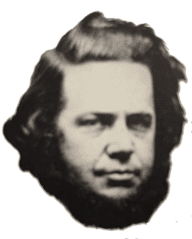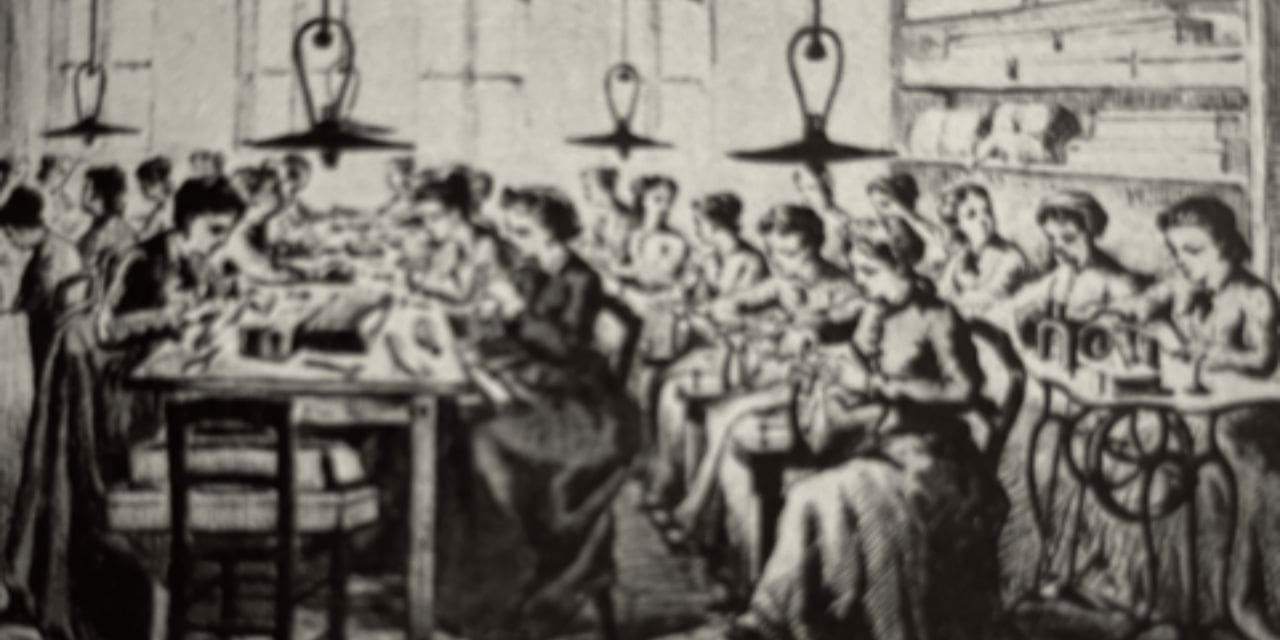This article is an adapted version of the feature that appears in Issue No. 12, June 2022 of the Needle’s Eye under the heading — Out of the Past (1845-1945), 100 Years of Machine Sewing.
The year 1845 ushered in an era of great scientific development in America, for it was the mechanical inventions of that period that set the pace for the tremendous industrial progress to follow. Cyrus McCormick, Samuel F. B. Morse, and Charles Goodyear had invented and were developing new processes in the fields of agriculture, communication, and industry, destined to revolutionize old methods of production and distribution. The textile trade was ripe for the introduction of a mechanical device to replace tedious hand sewing with needles and thread.
At that time, it was customary to give needlework to seamstresses residing in the vicinity of the centre of employment. A skillful needlewoman could, for several minutes, make forty to fifty stitches a minute. Her wages were wretchedly low, and by working twelve hours a day, and often most of the night, she was barely able to earn a meagre living.

It is little wonder that an ambitious young machinist like Elias Howe, Jr., watching his wife tediously perform one simple sewing operation over and over by hand, should consider the possibilities of a practical sewing machine and the fortune which awaited its inventor.
It was in the year 1843, when Howe was trying to support a family on US$9.00 a week, that the pressure of extreme poverty forced him to concentrate on his idea for a stitching machine. He took it for granted that all sewing must be performed in the same manner as hand stitching, and his first months of inventive effort were wasted on a device that duplicated the hand stitch.
This first invention consisted of a needle pointed at both ends with the eye in the middle, which was drawn up and down through the cloth and carried the thread with it at each thrust. Realizing the impracticability of this machine, Howe brooded over his failure until the question occurred to him, “Is it really necessary that a machine should imitate the performance of the human hand?”
This idea gave birth to the” shuttle stitch” machine, which used two threads and formed the stitch with the aid of a shuttle and reciprocating needle, with the eye near that point. By making a rough model of wood and wire, Howe was convinced that such a machine would sew.
By May of 1845, he had completed a working model — the first practical shuttle stitch machine — whose fundamental principles endure to this day and had obtained a patent in 1846. His invention was sold in England to William F. Thomas of Cheapside, London, a corset manufacturer, for £250.
In December of 1846, Thomas secured the English patent in his own name and engaged Howe to adapt the machine to his manufacturing purposes. The career of the inventor in London was unsuccessful and having pawned his American patent rights in England to pay various debts and his expenses to get home, Howe returned to America in 1849, in poverty.
The American public, in the meantime, had become interested in the sewing machine, and a few mechanics had completed machines that infringed on Howe’s patent rights.
Howe was able to secure the financial support of a wealthy capitalist and took court action against the infringers. As an outcome of the lawsuits, Howe was publicly acknowledged as the inventor of the shuttle sewing machine. He established himself in New York as a manufacturer, and after a few years was in a position to buy back the patents he had been forced to sell in England.
Royalties on machines made up until the expiration of his patent (September 1867) brought Howe an estimated sum of two million dollars. He was decorated with the Cross of the Legion of Honor by France but did not live long enough to enjoy the honour and awards due him. Elias Howe, Jr. died on October 3, 1867, in Brooklyn, New York.
he feasibility of sewing by the machine having been demonstrated, improvements and new inventions followed rapidly and discover more here https://sewingmachinebuffs.
In 1849, Allan B. Wilson, working entirely without knowledge of previous efforts, devised the rotary hook and bobbin combination. Wilson’s invention included the important four-motion feed for moving the work after every stitch.
The first practical single chain stitch machine was devised by James E. Gibbs of Virginia. His invention, patented in 1856, featured a rotary hook or looper, and a needle with a vertical motion only. Gibbs went into partnership with James Willcox of Philadelphia forming the Willcox & Gibbs Sewing Machine Company which made important advancements in the art of machine sewing.
A glove factory in 1870, showing the sewing machines in one of the first industrial applications.
To Isaac Singer, father of the Singer Manufacturing Company, should go the credit for developing the sewing machine for home use. Singer built various features into his first machine such as the yielding vertical presser foot to hold the work on the table and the wheel feed. This forced other competitive manufacturers to adapt their rather cumbersome machines to more practical public use.
All of these manufacturers – the Wheeler & Wilson Manufacturing Company, Willcox & Gibbs Sewing Machine Company, and the Singer Manufacturing Company – depended on a shuttle and bobbin for forming the stitch made by their machines. This meant that when the thread on the bobbin ran out, the machine had to be stopped so that a filled bobbin could be inserted.
In 1851, William O. Grover, a Boston tailor, patented his double chain stitch machine, designed to draw the thread directly from spools or cones, eliminating the necessity for re-threading the bobbin. This double-chain stitch was known as the “Grover & Baker” Stitch.
1881 witnessed the formation of another company which was to greatly influence the course of machine sewing. In that year, William S. North, Jasper W. Cory, and LorenzeMuther formed the Union Bag Machine Company (later Union Special Machine Company) for the production of a bag seaming machine. Recognizing the desirability of machines designed especially for given operations, they began introducing equipment into other fields, using a refinement of the Grover and Baker stitch, known as the “double-locked” stitch. This found ready acceptance in many places because it eliminated the use of bobbins necessary in producing the lock stitch.
Union Special developed a number of the types of stitches now in common use and many variations of the seams that were produced with these stitches. They gave to the industry machine attachments and accessories which reduced the length of specific sewing operations from a day’s work to a matter of minutes.
By 1900, special machines for specific operations were universally used. For the next thirty years, there was little improvement in the types of machines already in use, most of the effort being devoted to the creation of new types. By 1930, a machine had been produced for nearly every sewing operation. The beginning of the U.S. depression brought a demand for improved machines that could produce better merchandise at a lower cost. In answer to this, the sewing machinery industry developed refined and improved high-speed machinery in common use today.

